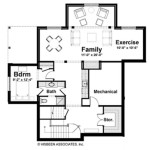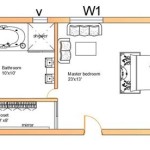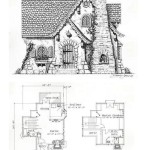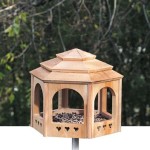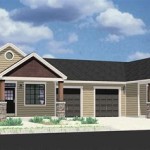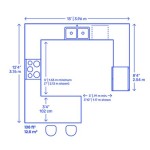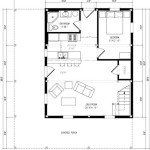Gothic Style Floor Plans: Architecture of Grandeur and Intricacy
Gothic architecture, a style that flourished in Europe during the High and Late Middle Ages, is instantly recognizable for its pointed arches, ribbed vaults, and flying buttresses. Transcending mere structural elements, Gothic design encapsulates a sense of aspiration, spirituality, and intricate detailing. While most readily associated with soaring cathedrals, the principles and aesthetics of Gothic architecture can also be applied to residential floor plans, albeit with adaptations to suit modern living and scale.
Understanding Gothic style floor plans involves recognizing the key elements that define the movement and how these elements can be translated into a functional and aesthetically pleasing living space. The core principles include a focus on verticality, the integration of light, the use of pointed arches and ribbed vaults, the incorporation of intricate ornamentation, and a general sense of grandeur and formality. When adapted for residential design, these elements often manifest in unique spatial arrangements, distinctive material choices, and a pronounced emphasis on decorative details.
Key Elements of Gothic Design for Residential Floor Plans
Translating the grandeur of Gothic architecture into a residential context requires a careful consideration of scale and functionality. While a full-blown Gothic cathedral replicated in a house would be impractical, the essence of the style can be captured through strategic implementation of key elements. These elements help establish the desired aesthetic and create a unique living experience.
The first major element is the incorporation of pointed arches. While structurally challenging to implement throughout an entire house, pointed arches can be used effectively for doorways, windows, and decorative niches. These arches immediately evoke the Gothic aesthetic, adding a touch of drama and visual interest. When combined with dark wood framing and stained glass accents, the effect is further enhanced.
The second element is the use of verticality. In Gothic cathedrals, verticality is emphasized to draw the eye upwards, symbolizing a connection to the divine. In residential design, this can be achieved through the use of tall ceilings, elongated windows, and vertical paneling. Even the placement of furniture and decorative elements can contribute to the sense of verticality. For example, tall bookshelves, grandfather clocks, and strategically placed artwork can all help to create the illusion of greater height and space.
The third element involves intricate ornamentation. Gothic architecture is characterized by its elaborate detailing, including tracery, carvings, and sculptural elements. While recreating the full extent of this ornamentation in a modern home may be cost-prohibitive, incorporating select details can add a touch of authenticity. Carved wood panels, ornate moldings, and decorative ironwork can be used to embellish walls, ceilings, and furniture. Stained glass windows, particularly those featuring geometric patterns or religious imagery, are another effective way to introduce intricate ornamentation. Furthermore, lighting fixtures with Gothic-inspired designs can complement the overall aesthetic.
Considerations for Adapting Gothic Style to Modern Living
While embracing the aesthetic principles of Gothic architecture, it is crucial to adapt them to the demands of modern living. Strict adherence to historical accuracy might result in a space that is impractical or uncomfortable. Therefore, a balanced approach is necessary to integrate Gothic elements seamlessly into a functional and contemporary floor plan.
One significant consideration involves the use of natural light. Gothic cathedrals, despite their imposing size and dark interiors, often incorporated large stained-glass windows to allow natural light to filter through. In a residential context, maximizing natural light is even more important. This can be achieved through the strategic placement of windows, skylights, and light wells. While stained glass can be incorporated, it should be used judiciously to avoid creating an overly dark or gloomy atmosphere. The use of lighter wall colors and reflective surfaces can also help to brighten the space and enhance the impact of natural light.
Another vital aspect is the functionality of the floor plan. Gothic architecture, while visually impressive, was not always known for its practicality. Modern living requires a floor plan that is efficient, comfortable, and adaptable to changing needs. This may involve incorporating open-plan living areas, modern kitchen and bathroom designs, and ample storage space. The challenge lies in integrating these modern amenities without compromising the overall Gothic aesthetic. For example, a modern kitchen can be seamlessly integrated into a Gothic-inspired interior by using dark wood cabinetry, stone countertops, and ornate hardware. Similarly, a modern bathroom can be given a Gothic touch through the use of pointed-arch mirrors, dark-colored tiles, and wrought-iron fixtures.
Finally, the choice of materials is crucial in achieving the desired Gothic aesthetic. Stone, wood, and iron are characteristic materials of Gothic architecture. These materials can be incorporated into residential design through the use of stone flooring, wood paneling, exposed wooden beams, and wrought-iron railings. The use of dark colors, such as deep reds, blues, and greens, can also contribute to the overall mood and atmosphere. However, it is important to balance these darker elements with lighter accents to prevent the space from feeling too oppressive.
Examples of Gothic Style Floor Plan Implementations
Several successful examples demonstrate how Gothic style can be adapted for residential floor plans, each showcasing a unique approach to incorporating key Gothic elements. These examples often blend historical inspiration with modern functionality, creating spaces that are both visually striking and livable.
One type of implementation focuses on the creation of a "Gothic Revival" living room. This often involves incorporating pointed arches above the fireplace and above the bookshelves. Deep jewel tone colors such as ruby red and emerald green adorn the walls. Plush velvet furniture and heavy drapes add to the overall opulence. A central chandelier, preferably with wrought iron detailing, provides dramatic lighting. The floor might be covered in dark wood or stone tiles, further enhancing the Gothic aesthetic.
Another example centers around a Gothic-inspired dining room. A long, rectangular table made from dark wood serves as the focal point. High-backed chairs, upholstered in velvet or brocade, provide comfortable seating. The walls are adorned with tapestries or framed artwork depicting medieval scenes. A candelabra provides soft, ambient lighting, encouraging a sense of intimacy and drama. The ceiling may feature exposed wooden beams or decorative plasterwork, adding to the overall sense of grandeur.
A third implementation is the use of Gothic elements in bedroom designs. Four-poster beds with elaborate canopies are a common feature. Dark wood furniture, such as dressers and nightstands, adds to the overall aesthetic. Stained glass windows, even if small, provide a touch of color and visual interest. Walls might be covered in dark-patterned wallpaper or fabric, creating a sense of warmth and intimacy. Lighting fixtures, such as sconces and lamps, often feature Gothic-inspired designs, adding to the overall atmosphere.
Each of these examples demonstrates that Gothic style can be successfully adapted for residential design. By carefully considering the key elements of the style, and by adapting them to the demands of modern living, it is possible to create spaces that are both visually stunning and highly functional.
Adaptation of the Gothic style for residential architecture depends on a careful blending of historical inspiration and contemporary necessities. By implementing elements like pointed arches, vertical emphasis, and detailed ornamentation, while ensuring functionality and practicality, it is possible to create unique and impressive living spaces.

Gothic Revival House Plans Google Search Victorian Vintage Floor

Charming Gothic Revival Cottage 1204 Sq Ft Architectural Designs 43002pf House Plans

Gothic Revival Style Christine Huckins Franck Architect Llc House Vintage Plans

Archi Maps Architecture House Victorian Plans Gothic

Gothic Revival Gem 43044pf Architectural Designs House Plans

Gothic Mansion Floor Plans Monster House Plan

Cathedral Floor Plan Glossary Ariel View The Pillars Of Earth

Fountainbleau Open Floor Plan Mansion House

Gothic Church Architecture Floor Plan Lesson Study Com

Gothic Mansion Design Plans From The 1800s
Related Posts

